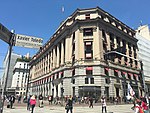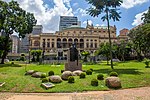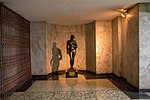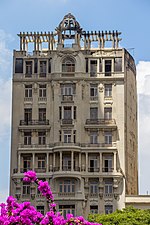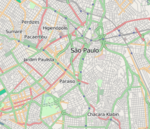Viaduto do Chá
Bridges in São PauloTourist attractions in São PauloViaducts

Viaduto do Chá ("Tea Viaduct") is a viaduct of São Paulo, Brazil. It was the first viaduct built in the city, and was instigated by Jules Martin, a French immigrant to the city. The 240-metre (790 ft) span crosses the Vale do Anhangabaú. Originally conceived in 1877, construction started in 1888 before being stopped one month later by a court case brought by local residents. Construction resumed in 1889, and the iron bridge was completed in 1892. The original viaduct was replaced in 1938 with a new concrete span. It often appears in TV interviews, as well as films and telenovelas set in São Paulo.
Excerpt from the Wikipedia article Viaduto do Chá (License: CC BY-SA 3.0, Authors, Images).Viaduto do Chá
Túnel Papa João Paulo II, São Paulo República (República)
Geographical coordinates (GPS) Address Nearby Places Show on map
Geographical coordinates (GPS)
| Latitude | Longitude |
|---|---|
| N -23.5467 ° | E -46.6378 ° |
Address
Túnel Papa João Paulo II (Praça do Correio)
Túnel Papa João Paulo II
01049-000 São Paulo, República (República)
São Paulo, Brazil
Open on Google Maps
